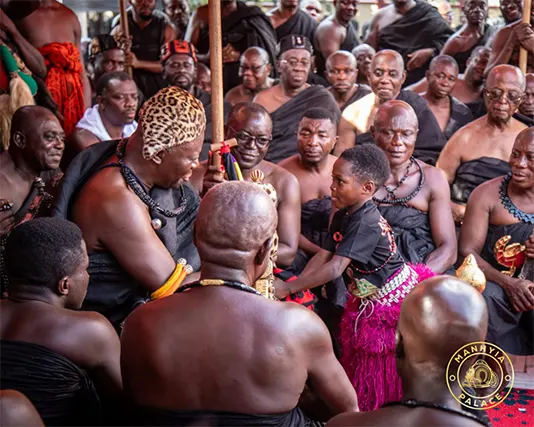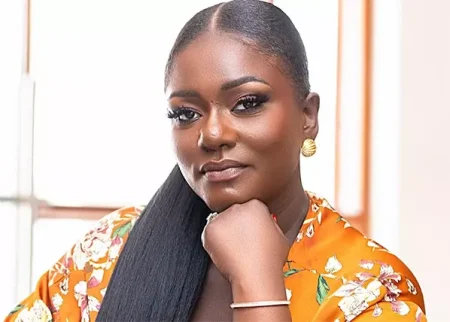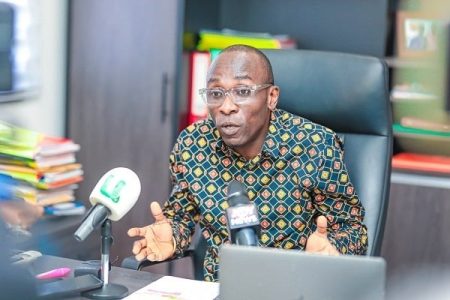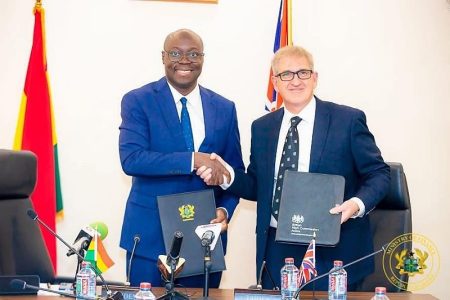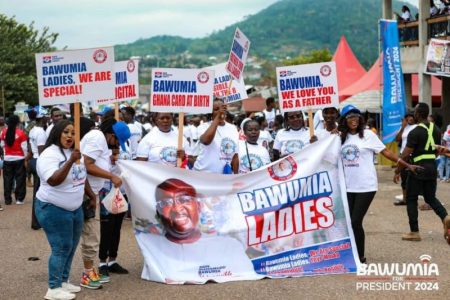The air in Kumasi was thick with tradition and solemnity on September 17th, as mourners gathered for the Dote Yie, the funeral rites of the Asantehemaa, Nana Ama Konadu Yiadom III. Amidst the somber atmosphere, a vibrant spark of youthful energy ignited the proceedings. A young boy, known as “Chief Justice,” a celebrated flag performer from Oguaa in the Central Region, captivated the assembled dignitaries with his remarkable display of skill and artistry. Part of the entourage of Osabarimba Kwesi Atta II, Omanhene of the Oguaa Traditional Area, Chief Justice brought a message of condolence and a vibrant performance to honor the late Asantehemaa and pay respects to the Asantehene, Otumfuo Osei Tutu II.
Chief Justice, already renowned as the youngest flag performer in the Central Region, commanded attention with his mastery of the “flag dance.” Wielding the Asafo flag, a powerful symbol of tradition and heritage, he moved with a grace and precision that belied his young age. The vibrant colors of the flag, coupled with the rhythmic beat of the traditional drums, created a mesmerizing spectacle that transcended the somber occasion. His performance, a vibrant testament to the rich cultural tapestry of Ghana, resonated deeply with the assembled linguists and dignitaries, drawing admiration and applause. It was a powerful reminder of the continuity of tradition and the vital role of the youth in preserving cultural heritage.
Beyond the spectacle of the performance, Chief Justice’s presence carried a deeper significance. He served as a living link between the Oguaa and Asante kingdoms, embodying the spirit of unity and shared heritage. His delivery of a message of commiseration from the Oguaa paramountcy to the Asantehene underscored the strong bond between these two influential traditional powers. This exchange, conveyed through the youthful messenger, symbolized the enduring respect and mutual support that has long characterized their relationship.
This poignant encounter marked the second time Chief Justice had stood before the Asantehene. Their first meeting occurred during a momentous occasion: the Asantehene’s historic visit to Cape Coast to commemorate the 25th anniversary of Osabarimba Kwesi Atta II’s reign. On that day, Chief Justice, with his youthful exuberance and mastery of the flag dance, had extended a vibrant welcome to the visiting monarch. The memory of that initial encounter, no doubt, added another layer of meaning to their reunion at the Asantehemaa’s funeral.
The young performer’s vibrant display of the traditional flag dance, set against the backdrop of the solemn funeral rites, was a striking juxtaposition of youthful energy and reverence for tradition. The red Asafo flag, swirling and dipping in time with the pulsating drums, became a focal point, captivating the attention of all present. His ability to channel the spirit of the dance with such precision and energy, especially given his young age, was truly remarkable. The performance spoke volumes about the deep-rooted cultural heritage that is passed down through generations, and the dedication of young Ghanaians to preserving and celebrating their traditions.
The Asantehene, deeply touched by the young boy’s performance and the message he conveyed, summoned Chief Justice to sit beside him and Osabarimba Kwesi Atta II. This gesture of honor, bestowed upon the young flag bearer, spoke volumes about the impact of his performance and the respect it garnered. Now affectionately referred to as “Otumfuo’s friend,” Chief Justice’s encounter with the Asantehene transcended a mere performance; it became a symbolic bridge between two powerful traditional entities, and a testament to the power of culture to unite and inspire. The image of the young boy, seated beside the Asantehene, serves as a powerful symbol of hope, continuity, and the enduring strength of Ghanaian tradition.





